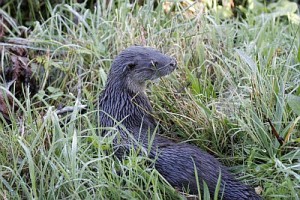 The only otter found in the UK is the European otter Lutra lutra. They have been recorded on virtually every type of water body, from rivers through to ponds and lakes. They will also make use of coastal habitats, particularly in Scotland where they easier to see because they are more active during the day. In England and Wales they are mostly nocturnal, being active from dusk to dawn.
The only otter found in the UK is the European otter Lutra lutra. They have been recorded on virtually every type of water body, from rivers through to ponds and lakes. They will also make use of coastal habitats, particularly in Scotland where they easier to see because they are more active during the day. In England and Wales they are mostly nocturnal, being active from dusk to dawn.
A male otter will occupy a ‘home range’ of up to 40km or more, which will consist of a stretch of river, including associated tributaries, ditches, ponds and lakes. The size will depend on food availability and shelter, as well as the presence of neighbouring otters. A females range will be roughly half the size of this, and part of her territory will include somewhere quiet for breeding such as a smaller tributary stream. Otters are very territorial and injuries sustained from territorial fighting are a common cause of death.
Within a home range an otter will have a number of resting sites. These can be above ground couches in scrub or rank vegetation, or below ground holts, for example in cavities in tree roots.
The main bulk of an otters diet is fish, but they will also take a small proportion of amphibians, waterfowl, and small mammals. They have no particular preference over what species of fish they take; often feeding on what is most abundant.
Otters will breed all year round, with females starting to breed in their second or third years. They will give birth to two or three cubs who will stay with her up to a year. The male has little or no involvement in the upbringing of the cubs. Most otters in the wild will not live for more than three or four years, so many females may never have more than one litter of cubs.